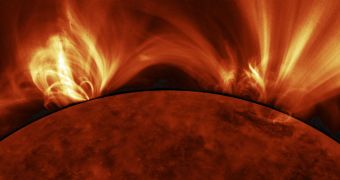According to officials at the American space agency, an instrument aboard one of the latests telescopes to be launched in Earth's orbit is currently allowing solar physicists to keep the solar corona under 24/7 monitoring. This was never possible before.
The achievement is made possible by the Atmospheric Imaging Assembly (AIA) instrument aboard the NASA Solar Dynamics Observatory (SDO), which launched on February 11, 2010.
The mission is a part of the space agency's Living With a Star (LWS) program, and features scientific instruments that are uniquely designed to provide the best quality data of their respective targets.
Solar physicists say that the corona is the shimmering layer of the Sun that is apparent from Earth during a total eclipse. In a weird twist, this layer of the solar atmosphere is a lot hotter than the actual stellar core, but also less bright for direct observations.
The brightness of the core hides the shimmers of the corona from any Sun-watching spacecraft, and so engineers need to turn to various tricks to enable studies of the type the SDO is conducting.
“We can follow the corona all the way down to the Sun's surface,” explains Harvard-Smithsonian Center for Astrophysics (CfA) expert Leon Golub. AIA enables the study of the innermost corona 24 hours a day, 7 days a week, he adds.
In the past, studying the solar corona was made possible through the use of a coronagraphy, an instrument that blocked the light of the Sun, and let only the brightness of the corona shine through.
What the instrument basically did was create a perennial eclipse, in whose dark cone a spacecraft was lurking. The probe and its Sun-blocking mechanism move in tune, and enable intricate studies.
But the issue with this technique is that only the outer corona is visible. What AIA does is enable experts to fill the gap between the outer and inner coronas.
“The resulting images highlight the ever-changing connections between gas captured by the Sun's magnetic field and gas escaping into interplanetary space,” CfA experts say in a press release.
“The AIA solar images, with better-than-HD quality views, show magnetic structures and dynamics that we've never seen before on the Sun. This is a whole new area of study that's just beginning,” explains CfA astronomer Steven Cranmer.
The CfA, a joint collaboration between the Smithsonian Astrophysical Observatory and the Harvard College Observatory, analyzes SDO data to study the origin, evolution and ultimate fate of the Universe.
The telescope was built, and is managed, by experts at the NASA Goddard Space Flight Center (GSFC), in Greenbelt, Maryland.

 14 DAY TRIAL //
14 DAY TRIAL //